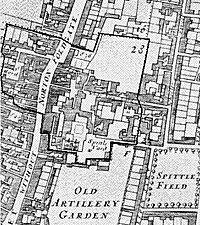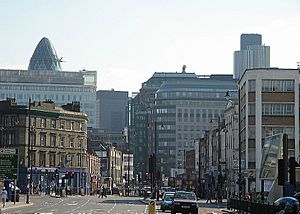Liberty of Norton Folgate facts for kids
| Norton Folgate | |
 Norton Folgate in 1681  |
|
| Geography | |
| Status | Liberty (until 1900) Extra-parochial area (until 1858) Civil parish (1858—1921) |
| 1901 area | 8 acres (0.032 km2) |
| HQ | Norton Folgate Street (c.1544-1744) White Lion Street (1744-1901) |
| History | |
| Abolished | 1900 (liberty) 1921 (civil parish) |
| Succeeded by | Metropolitan Borough of Shoreditch Metropolitan Borough of Stepney |
Quick facts for kids Demography |
|
|---|---|
| 1801 population | 1,752 |
| 1851 population | 1,771 |
| 1901 population - 1901 density |
1,663 208/acre |

Norton Folgate was a special area in Middlesex, England. It was like a small independent district, right next to the City of London. This area is now part of the East End of London.
It was located between the Bishopsgate part of the City of London to the south. To the north was the parish of St Leonard, Shoreditch. To the east was the parish of Spitalfields.
Norton Folgate was part of the Tower Division, also known as the Tower Hamlets. This district stopped being a separate area in 1900. It joined with the Metropolitan Borough of Stepney. Today, its former land is split between the City of London and the London Borough of Tower Hamlets. This happened after some boundary changes in the 1990s.
Contents
What Does "Norton Folgate" Mean?
The name Nortune was first recorded around 1110. It means "north farmstead" in Old English. The word "Folgate" might come from a family name, Foliot. This could refer to Gilbert Foliot, who was a Bishop of London. It might also be about Richard Foliot, a priest at Old St Paul's Cathedral.
Another idea from 1868 says Folgate comes from the Saxon word Foldweg. This word means "a highway." It refers to the old Roman Road (Ermine Street) that went through the area. The name is still remembered today in the street called Norton Folgate. It's also the title of a 2009 album by the band Madness, called The Liberty of Norton Folgate.
A Brief History of Norton Folgate
Norton Folgate started as the land around the Priory and Hospital of St Mary Spital. A priory is a type of monastery. When the monasteries were closed down during the English Reformation, the land went back to the Crown. But it kept its special status as an independent liberty.
This former liberty was about 8.7 acres (35,000 m2) in size. It included streets like Folgate Street, Spital Square, Elder Street, Fleur de Lis Street, and Blossom Street. Maps from the 1700s show that an area west of Bishopsgate was also part of Norton Folgate. This was likely part of the larger manor, not the liberty itself.
Originally, Norton Folgate stretched from what is now Worship Street (then Hog Lane). It was a narrow strip running next to Bishopsgate. By the 1800s, it had shrunk to a small plot between Primrose Street and Worship Street. Some believe Norton Folgate was the nine acres of land that priests of St Paul's held near Bishopsgate. This was recorded in the Domesday Survey.
Industries and Entertainment
In the 1700s, breweries on Hog Lane and White Lion Street made a type of beer called porter. Later, the Gas Light and Coke Company built gas works here around 1812. They provided gas lighting to Bishopsgate and the surrounding area. These works operated until 1871. After that, the site was used for coaling trains and then as a taxi yard. It was redeveloped around 2000.
The famous playwright Christopher Marlowe once lived in Norton Folgate. The area continued its connection to theatre. In 1837, the City of London Theatre was built by Samuel Beazley. This theatre showed "domestic" and temperance plays. It closed in 1868. Famous performances included plays based on The Pickwick Papers and Nicholas Nickleby.
Changes to the Liberty's Boundaries
Norton Folgate remained a liberty until October 1900. It continued to exist as a civil parish until 1921. The area west of Bishopsgate became part of Shoreditch. Shoreditch later became part of the London Borough of Hackney in 1965. After boundary changes in the 1990s, this area is now part of the City of London.
The rest of the parish, east of Bishopsgate, became part of the Metropolitan Borough of Stepney. It was abolished in 1921 and joined the parish of Spitalfields. In 2008, some local people argued that Norton Folgate might still exist as a liberty. They found old documents that suggested its abolition in 1900 was not completely valid.
How Was Norton Folgate Governed?
In 1732, the Parish Clerks of Shoreditch said that "All the Affairs of the Liberty are managed by the Ancients." These "ancients" were like a local council or "Vestry." They were likely important landowners. These "ancient inhabitants" took turns holding different jobs:
- Headborough: A leader, similar to a mayor.
- Overseers of the Poor: Two people who managed rents and helped the needy.
- Constable: Supervised three Beadles, who were like local police.
- Scavenger: Managed street cleaning.
There were ten "ancient inhabitants." They had to take on these roles or pay a fine to avoid them. They chose new members from other residents of the Liberty.
Later, a new law changed these old roles. A more democratic Board of Trustees took over. These twenty trustees managed the Liberty from the Court House. This building was in the middle of Norton Folgate Street. The trustees were in charge of public services. This included sewers, street lighting, and keeping pavements in good condition.
In 1743, the old Court House was taken down. The manor courts then met in a building on White Lion Street. This building was used for trustee meetings until 1900. It was demolished in the 1960s.
Norton Folgate was one of the areas that made up the Tower Division. This area was known for its military ties to the Tower of London. But it also had a role in local government.
In 1855, the liberty became part of the Whitechapel District. In 1897, the trustees thought about joining the City of London. They considered this with the nearby Liberty of the Old Artillery Ground, but they did not go through with it. In 1900, the liberty merged into the Metropolitan Borough of Stepney. The last meeting of the trustees was on October 24, 1900. William Chillingworth was the last chairman of the Board of Trustees.
Population and Size
The liberty of Norton Folgate covered about 8 acres (3 ha). Here's how the population changed over the years, according to the Census:
Liberty of Norton Folgate Population (1801-1901)
| Year | 1801 | 1811 | 1821 | 1831 | 1841 | 1851 | 1861 | 1871 | 1881 | 1891 | 1901 |
|---|---|---|---|---|---|---|---|---|---|---|---|
| Population | 1,752 | 1,716 | 1,896 | 1,918 | 1,674 | 1,771 | 1,873 | 1,550 | 1,528 | 1,449 | 1,663 |
See also



